BM631 Research Methods CW2: Leadership and Motivation in UK Retail
VerifiedAdded on 2023/06/10
|8
|1520
|305
Report
AI Summary
This report critically reflects on leadership and motivation within the UK retail industry. It aims to assess the impact of leadership motivation on employee performance, focusing on key objectives such as discussing the influence of leadership motivation, identifying important motivational factors, analyzing miscommunication, and evaluating participant responses regarding leadership and motivation. The research employs a methodology based on Saunders' research onion framework, utilizing positivism philosophy, a deductive approach, a survey strategy, and both quantitative and qualitative research methods. Ethical considerations, including respect for autonomy, scientific integrity, social responsibility, and maximizing benefit while minimizing harm, are carefully addressed. Primary data is collected through questionnaires and interviews with a sample size of 100 participants, using random sampling techniques.
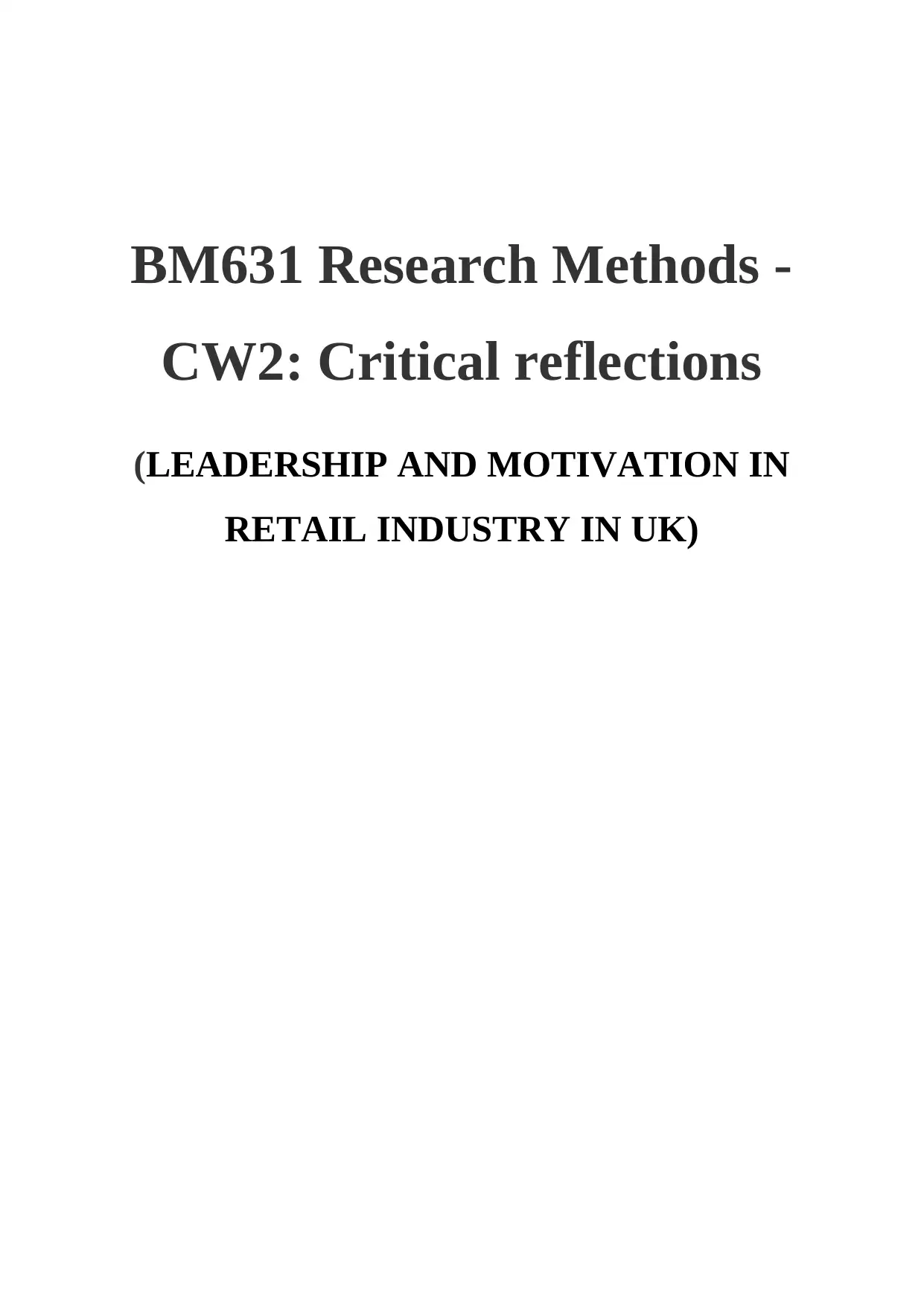
BM631 Research Methods -
CW2: Critical reflections
(LEADERSHIP AND MOTIVATION IN
RETAIL INDUSTRY IN UK)
CW2: Critical reflections
(LEADERSHIP AND MOTIVATION IN
RETAIL INDUSTRY IN UK)
Paraphrase This Document
Need a fresh take? Get an instant paraphrase of this document with our AI Paraphraser
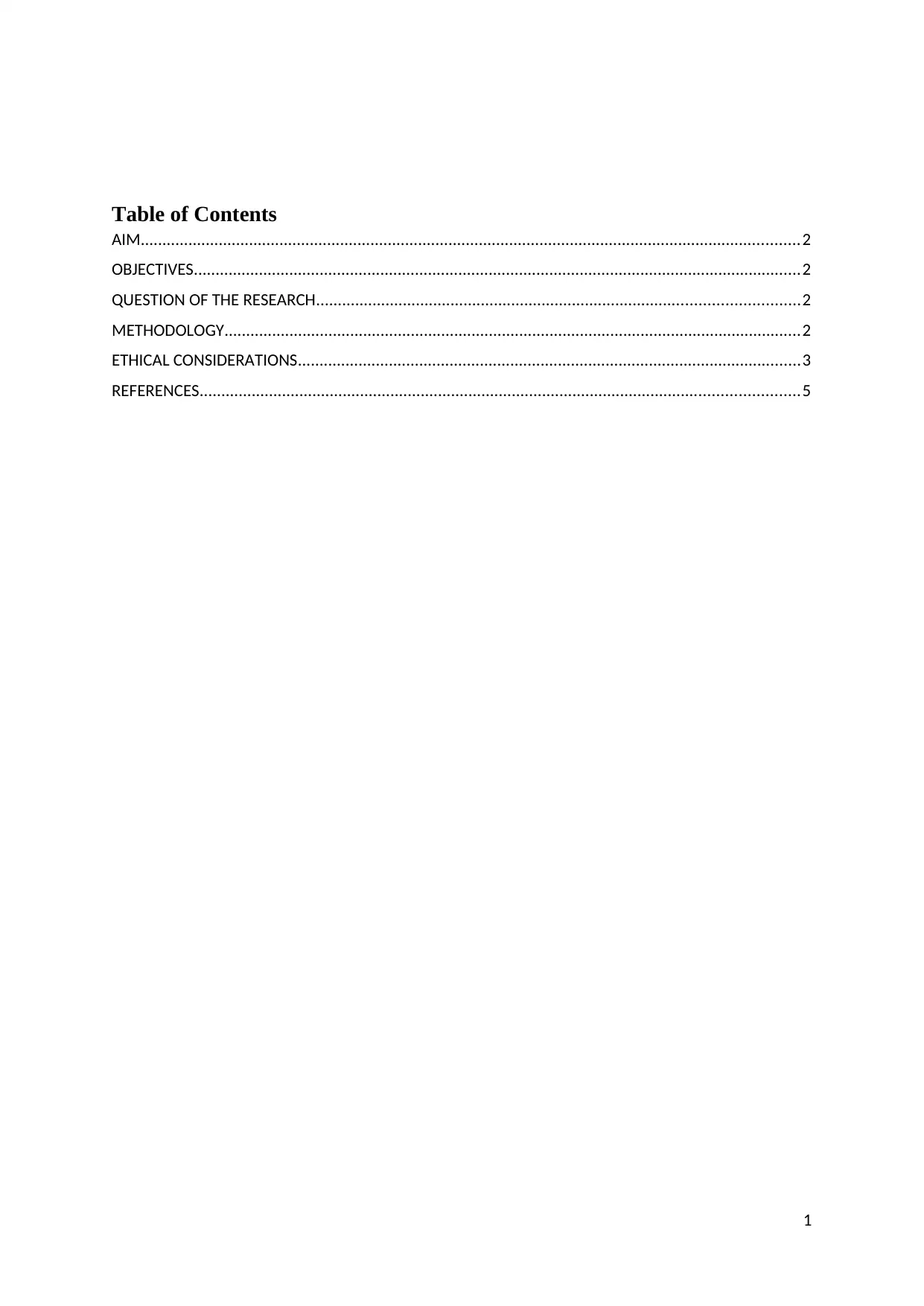
Table of Contents
AIM........................................................................................................................................................2
OBJECTIVES............................................................................................................................................2
QUESTION OF THE RESEARCH...............................................................................................................2
METHODOLOGY.....................................................................................................................................2
ETHICAL CONSIDERATIONS....................................................................................................................3
REFERENCES..........................................................................................................................................5
1
AIM........................................................................................................................................................2
OBJECTIVES............................................................................................................................................2
QUESTION OF THE RESEARCH...............................................................................................................2
METHODOLOGY.....................................................................................................................................2
ETHICAL CONSIDERATIONS....................................................................................................................3
REFERENCES..........................................................................................................................................5
1
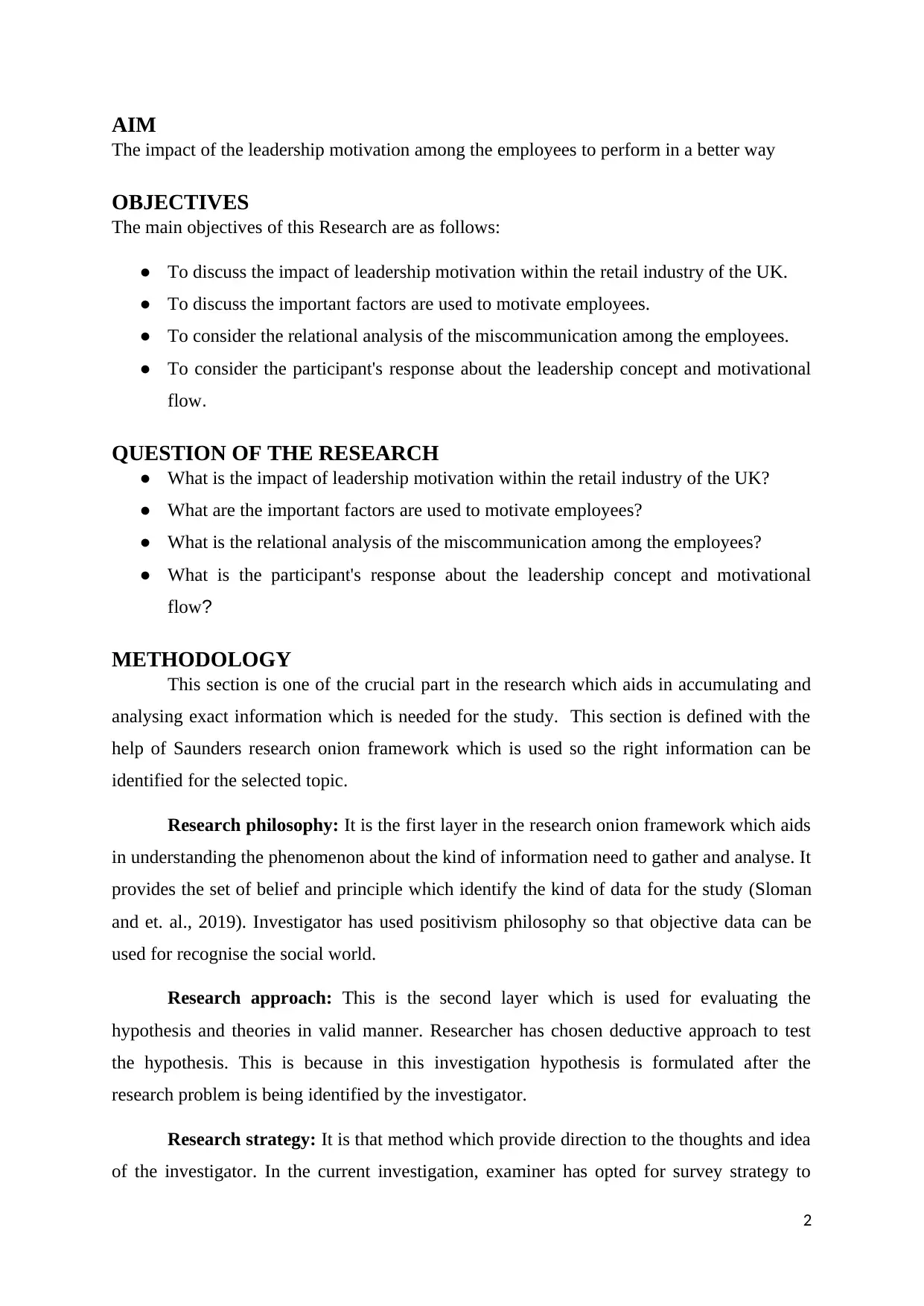
AIM
The impact of the leadership motivation among the employees to perform in a better way
OBJECTIVES
The main objectives of this Research are as follows:
● To discuss the impact of leadership motivation within the retail industry of the UK.
● To discuss the important factors are used to motivate employees.
● To consider the relational analysis of the miscommunication among the employees.
● To consider the participant's response about the leadership concept and motivational
flow.
QUESTION OF THE RESEARCH
● What is the impact of leadership motivation within the retail industry of the UK?
● What are the important factors are used to motivate employees?
● What is the relational analysis of the miscommunication among the employees?
● What is the participant's response about the leadership concept and motivational
flow?
METHODOLOGY
This section is one of the crucial part in the research which aids in accumulating and
analysing exact information which is needed for the study. This section is defined with the
help of Saunders research onion framework which is used so the right information can be
identified for the selected topic.
Research philosophy: It is the first layer in the research onion framework which aids
in understanding the phenomenon about the kind of information need to gather and analyse. It
provides the set of belief and principle which identify the kind of data for the study (Sloman
and et. al., 2019). Investigator has used positivism philosophy so that objective data can be
used for recognise the social world.
Research approach: This is the second layer which is used for evaluating the
hypothesis and theories in valid manner. Researcher has chosen deductive approach to test
the hypothesis. This is because in this investigation hypothesis is formulated after the
research problem is being identified by the investigator.
Research strategy: It is that method which provide direction to the thoughts and idea
of the investigator. In the current investigation, examiner has opted for survey strategy to
2
The impact of the leadership motivation among the employees to perform in a better way
OBJECTIVES
The main objectives of this Research are as follows:
● To discuss the impact of leadership motivation within the retail industry of the UK.
● To discuss the important factors are used to motivate employees.
● To consider the relational analysis of the miscommunication among the employees.
● To consider the participant's response about the leadership concept and motivational
flow.
QUESTION OF THE RESEARCH
● What is the impact of leadership motivation within the retail industry of the UK?
● What are the important factors are used to motivate employees?
● What is the relational analysis of the miscommunication among the employees?
● What is the participant's response about the leadership concept and motivational
flow?
METHODOLOGY
This section is one of the crucial part in the research which aids in accumulating and
analysing exact information which is needed for the study. This section is defined with the
help of Saunders research onion framework which is used so the right information can be
identified for the selected topic.
Research philosophy: It is the first layer in the research onion framework which aids
in understanding the phenomenon about the kind of information need to gather and analyse. It
provides the set of belief and principle which identify the kind of data for the study (Sloman
and et. al., 2019). Investigator has used positivism philosophy so that objective data can be
used for recognise the social world.
Research approach: This is the second layer which is used for evaluating the
hypothesis and theories in valid manner. Researcher has chosen deductive approach to test
the hypothesis. This is because in this investigation hypothesis is formulated after the
research problem is being identified by the investigator.
Research strategy: It is that method which provide direction to the thoughts and idea
of the investigator. In the current investigation, examiner has opted for survey strategy to
2
⊘ This is a preview!⊘
Do you want full access?
Subscribe today to unlock all pages.

Trusted by 1+ million students worldwide
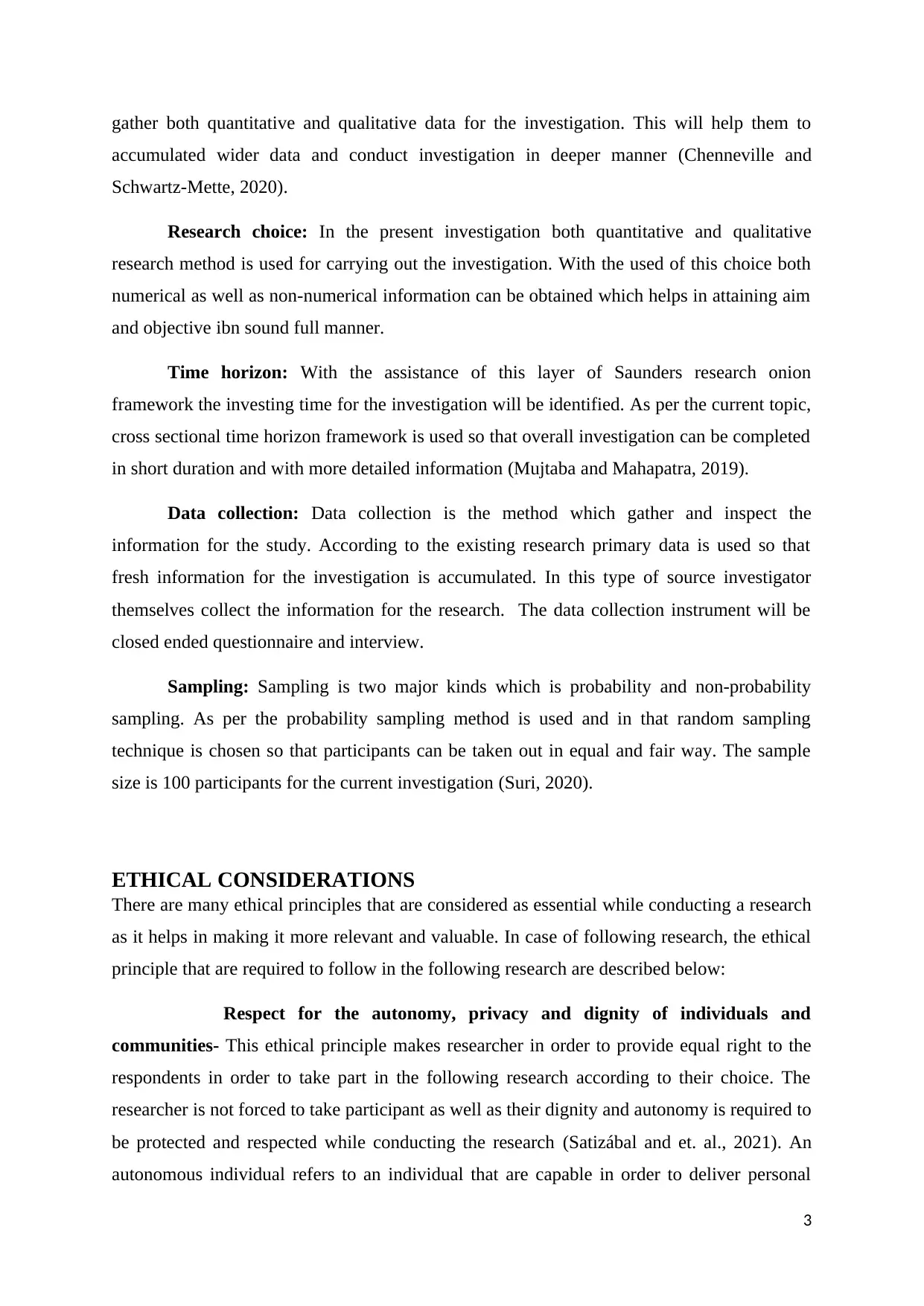
gather both quantitative and qualitative data for the investigation. This will help them to
accumulated wider data and conduct investigation in deeper manner (Chenneville and
Schwartz-Mette, 2020).
Research choice: In the present investigation both quantitative and qualitative
research method is used for carrying out the investigation. With the used of this choice both
numerical as well as non-numerical information can be obtained which helps in attaining aim
and objective ibn sound full manner.
Time horizon: With the assistance of this layer of Saunders research onion
framework the investing time for the investigation will be identified. As per the current topic,
cross sectional time horizon framework is used so that overall investigation can be completed
in short duration and with more detailed information (Mujtaba and Mahapatra, 2019).
Data collection: Data collection is the method which gather and inspect the
information for the study. According to the existing research primary data is used so that
fresh information for the investigation is accumulated. In this type of source investigator
themselves collect the information for the research. The data collection instrument will be
closed ended questionnaire and interview.
Sampling: Sampling is two major kinds which is probability and non-probability
sampling. As per the probability sampling method is used and in that random sampling
technique is chosen so that participants can be taken out in equal and fair way. The sample
size is 100 participants for the current investigation (Suri, 2020).
ETHICAL CONSIDERATIONS
There are many ethical principles that are considered as essential while conducting a research
as it helps in making it more relevant and valuable. In case of following research, the ethical
principle that are required to follow in the following research are described below:
Respect for the autonomy, privacy and dignity of individuals and
communities- This ethical principle makes researcher in order to provide equal right to the
respondents in order to take part in the following research according to their choice. The
researcher is not forced to take participant as well as their dignity and autonomy is required to
be protected and respected while conducting the research (Satizábal and et. al., 2021). An
autonomous individual refers to an individual that are capable in order to deliver personal
3
accumulated wider data and conduct investigation in deeper manner (Chenneville and
Schwartz-Mette, 2020).
Research choice: In the present investigation both quantitative and qualitative
research method is used for carrying out the investigation. With the used of this choice both
numerical as well as non-numerical information can be obtained which helps in attaining aim
and objective ibn sound full manner.
Time horizon: With the assistance of this layer of Saunders research onion
framework the investing time for the investigation will be identified. As per the current topic,
cross sectional time horizon framework is used so that overall investigation can be completed
in short duration and with more detailed information (Mujtaba and Mahapatra, 2019).
Data collection: Data collection is the method which gather and inspect the
information for the study. According to the existing research primary data is used so that
fresh information for the investigation is accumulated. In this type of source investigator
themselves collect the information for the research. The data collection instrument will be
closed ended questionnaire and interview.
Sampling: Sampling is two major kinds which is probability and non-probability
sampling. As per the probability sampling method is used and in that random sampling
technique is chosen so that participants can be taken out in equal and fair way. The sample
size is 100 participants for the current investigation (Suri, 2020).
ETHICAL CONSIDERATIONS
There are many ethical principles that are considered as essential while conducting a research
as it helps in making it more relevant and valuable. In case of following research, the ethical
principle that are required to follow in the following research are described below:
Respect for the autonomy, privacy and dignity of individuals and
communities- This ethical principle makes researcher in order to provide equal right to the
respondents in order to take part in the following research according to their choice. The
researcher is not forced to take participant as well as their dignity and autonomy is required to
be protected and respected while conducting the research (Satizábal and et. al., 2021). An
autonomous individual refers to an individual that are capable in order to deliver personal
3
Paraphrase This Document
Need a fresh take? Get an instant paraphrase of this document with our AI Paraphraser
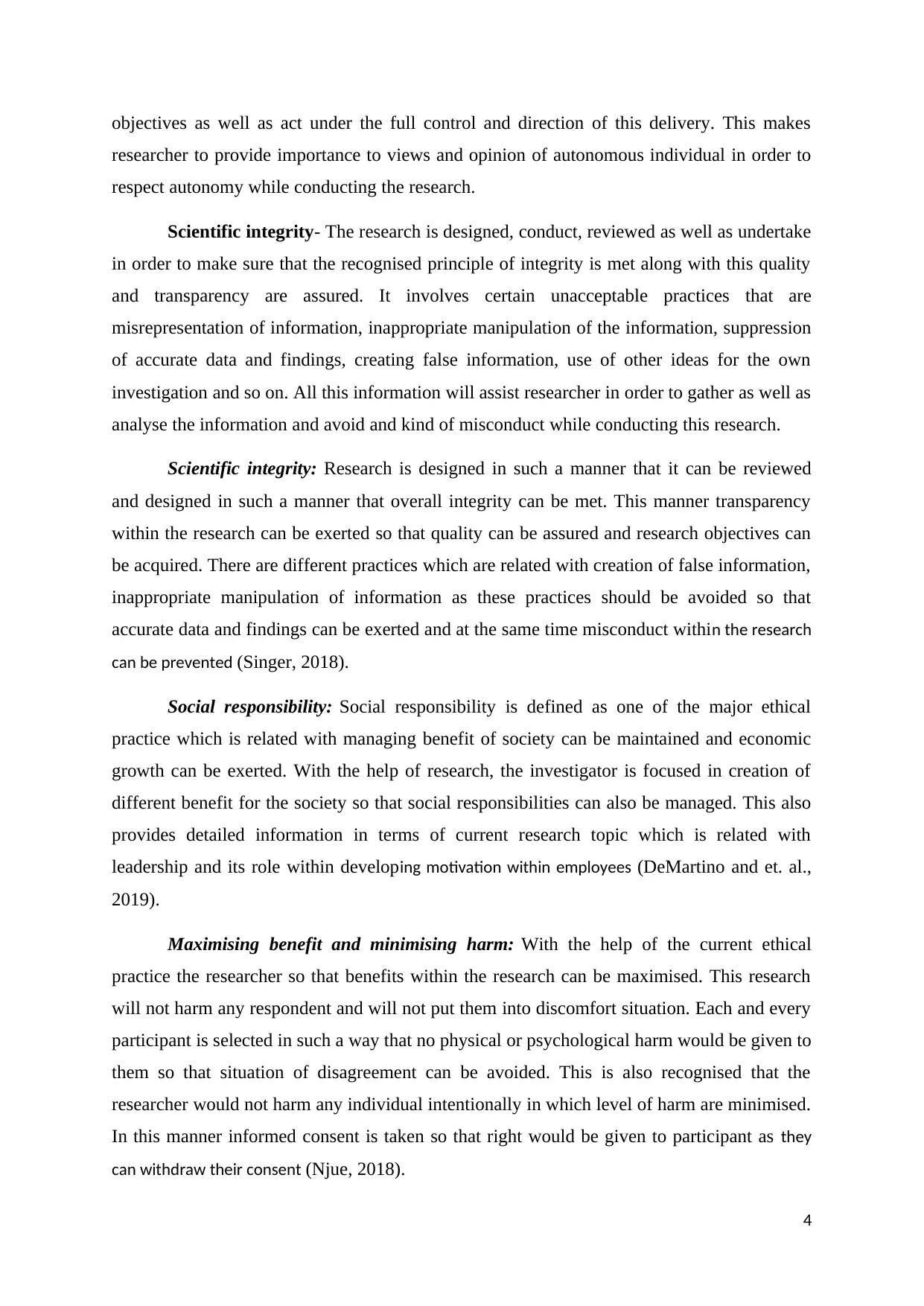
objectives as well as act under the full control and direction of this delivery. This makes
researcher to provide importance to views and opinion of autonomous individual in order to
respect autonomy while conducting the research.
Scientific integrity- The research is designed, conduct, reviewed as well as undertake
in order to make sure that the recognised principle of integrity is met along with this quality
and transparency are assured. It involves certain unacceptable practices that are
misrepresentation of information, inappropriate manipulation of the information, suppression
of accurate data and findings, creating false information, use of other ideas for the own
investigation and so on. All this information will assist researcher in order to gather as well as
analyse the information and avoid and kind of misconduct while conducting this research.
Scientific integrity: Research is designed in such a manner that it can be reviewed
and designed in such a manner that overall integrity can be met. This manner transparency
within the research can be exerted so that quality can be assured and research objectives can
be acquired. There are different practices which are related with creation of false information,
inappropriate manipulation of information as these practices should be avoided so that
accurate data and findings can be exerted and at the same time misconduct within the research
can be prevented (Singer, 2018).
Social responsibility: Social responsibility is defined as one of the major ethical
practice which is related with managing benefit of society can be maintained and economic
growth can be exerted. With the help of research, the investigator is focused in creation of
different benefit for the society so that social responsibilities can also be managed. This also
provides detailed information in terms of current research topic which is related with
leadership and its role within developing motivation within employees (DeMartino and et. al.,
2019).
Maximising benefit and minimising harm: With the help of the current ethical
practice the researcher so that benefits within the research can be maximised. This research
will not harm any respondent and will not put them into discomfort situation. Each and every
participant is selected in such a way that no physical or psychological harm would be given to
them so that situation of disagreement can be avoided. This is also recognised that the
researcher would not harm any individual intentionally in which level of harm are minimised.
In this manner informed consent is taken so that right would be given to participant as they
can withdraw their consent (Njue, 2018).
4
researcher to provide importance to views and opinion of autonomous individual in order to
respect autonomy while conducting the research.
Scientific integrity- The research is designed, conduct, reviewed as well as undertake
in order to make sure that the recognised principle of integrity is met along with this quality
and transparency are assured. It involves certain unacceptable practices that are
misrepresentation of information, inappropriate manipulation of the information, suppression
of accurate data and findings, creating false information, use of other ideas for the own
investigation and so on. All this information will assist researcher in order to gather as well as
analyse the information and avoid and kind of misconduct while conducting this research.
Scientific integrity: Research is designed in such a manner that it can be reviewed
and designed in such a manner that overall integrity can be met. This manner transparency
within the research can be exerted so that quality can be assured and research objectives can
be acquired. There are different practices which are related with creation of false information,
inappropriate manipulation of information as these practices should be avoided so that
accurate data and findings can be exerted and at the same time misconduct within the research
can be prevented (Singer, 2018).
Social responsibility: Social responsibility is defined as one of the major ethical
practice which is related with managing benefit of society can be maintained and economic
growth can be exerted. With the help of research, the investigator is focused in creation of
different benefit for the society so that social responsibilities can also be managed. This also
provides detailed information in terms of current research topic which is related with
leadership and its role within developing motivation within employees (DeMartino and et. al.,
2019).
Maximising benefit and minimising harm: With the help of the current ethical
practice the researcher so that benefits within the research can be maximised. This research
will not harm any respondent and will not put them into discomfort situation. Each and every
participant is selected in such a way that no physical or psychological harm would be given to
them so that situation of disagreement can be avoided. This is also recognised that the
researcher would not harm any individual intentionally in which level of harm are minimised.
In this manner informed consent is taken so that right would be given to participant as they
can withdraw their consent (Njue, 2018).
4

5
⊘ This is a preview!⊘
Do you want full access?
Subscribe today to unlock all pages.

Trusted by 1+ million students worldwide
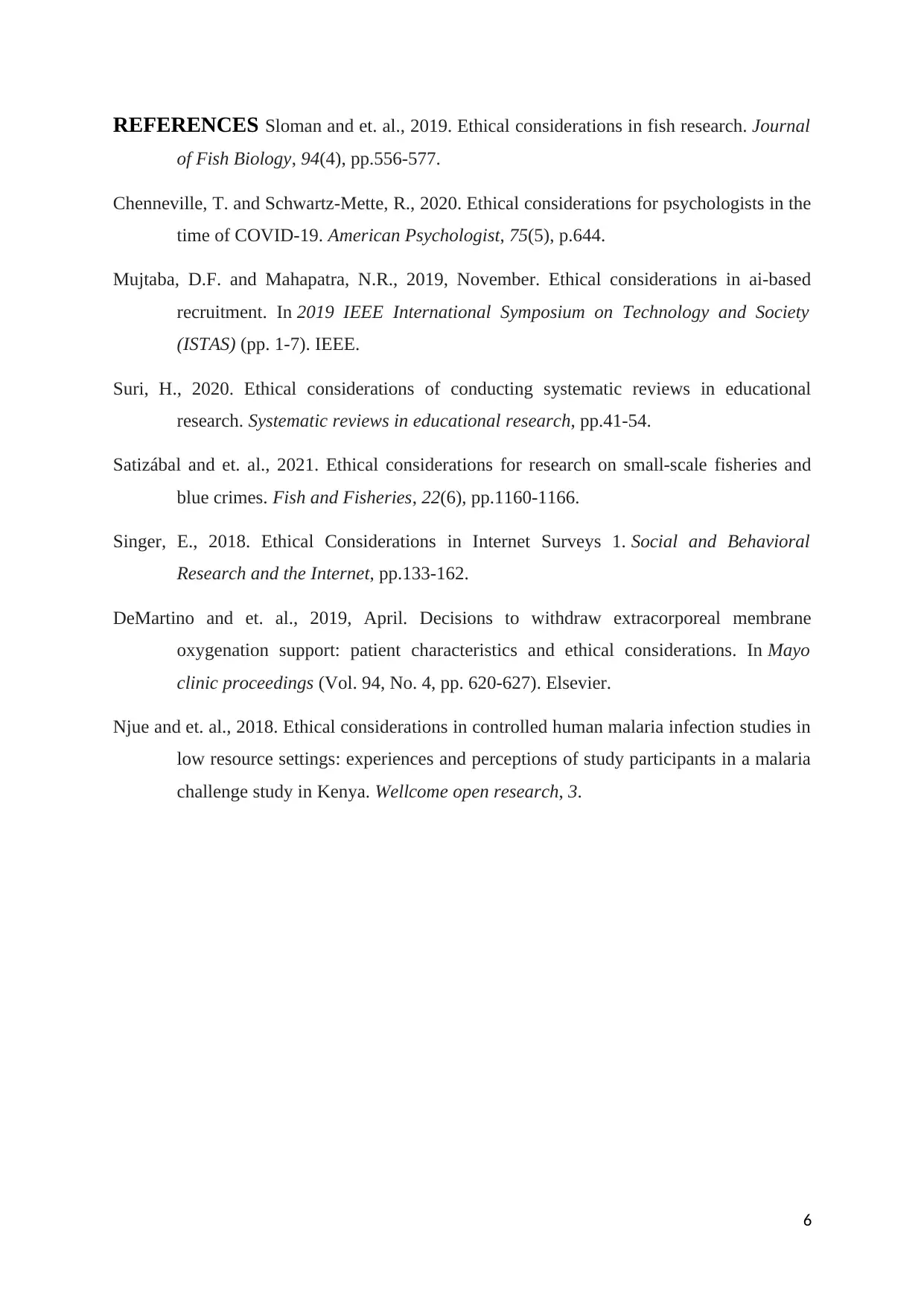
REFERENCES Sloman and et. al., 2019. Ethical considerations in fish research. Journal
of Fish Biology, 94(4), pp.556-577.
Chenneville, T. and Schwartz-Mette, R., 2020. Ethical considerations for psychologists in the
time of COVID-19. American Psychologist, 75(5), p.644.
Mujtaba, D.F. and Mahapatra, N.R., 2019, November. Ethical considerations in ai-based
recruitment. In 2019 IEEE International Symposium on Technology and Society
(ISTAS) (pp. 1-7). IEEE.
Suri, H., 2020. Ethical considerations of conducting systematic reviews in educational
research. Systematic reviews in educational research, pp.41-54.
Satizábal and et. al., 2021. Ethical considerations for research on small‐scale fisheries and
blue crimes. Fish and Fisheries, 22(6), pp.1160-1166.
Singer, E., 2018. Ethical Considerations in Internet Surveys 1. Social and Behavioral
Research and the Internet, pp.133-162.
DeMartino and et. al., 2019, April. Decisions to withdraw extracorporeal membrane
oxygenation support: patient characteristics and ethical considerations. In Mayo
clinic proceedings (Vol. 94, No. 4, pp. 620-627). Elsevier.
Njue and et. al., 2018. Ethical considerations in controlled human malaria infection studies in
low resource settings: experiences and perceptions of study participants in a malaria
challenge study in Kenya. Wellcome open research, 3.
6
of Fish Biology, 94(4), pp.556-577.
Chenneville, T. and Schwartz-Mette, R., 2020. Ethical considerations for psychologists in the
time of COVID-19. American Psychologist, 75(5), p.644.
Mujtaba, D.F. and Mahapatra, N.R., 2019, November. Ethical considerations in ai-based
recruitment. In 2019 IEEE International Symposium on Technology and Society
(ISTAS) (pp. 1-7). IEEE.
Suri, H., 2020. Ethical considerations of conducting systematic reviews in educational
research. Systematic reviews in educational research, pp.41-54.
Satizábal and et. al., 2021. Ethical considerations for research on small‐scale fisheries and
blue crimes. Fish and Fisheries, 22(6), pp.1160-1166.
Singer, E., 2018. Ethical Considerations in Internet Surveys 1. Social and Behavioral
Research and the Internet, pp.133-162.
DeMartino and et. al., 2019, April. Decisions to withdraw extracorporeal membrane
oxygenation support: patient characteristics and ethical considerations. In Mayo
clinic proceedings (Vol. 94, No. 4, pp. 620-627). Elsevier.
Njue and et. al., 2018. Ethical considerations in controlled human malaria infection studies in
low resource settings: experiences and perceptions of study participants in a malaria
challenge study in Kenya. Wellcome open research, 3.
6
Paraphrase This Document
Need a fresh take? Get an instant paraphrase of this document with our AI Paraphraser

7
1 out of 8
Related Documents
Your All-in-One AI-Powered Toolkit for Academic Success.
+13062052269
info@desklib.com
Available 24*7 on WhatsApp / Email
![[object Object]](/_next/static/media/star-bottom.7253800d.svg)
Unlock your academic potential
Copyright © 2020–2025 A2Z Services. All Rights Reserved. Developed and managed by ZUCOL.





